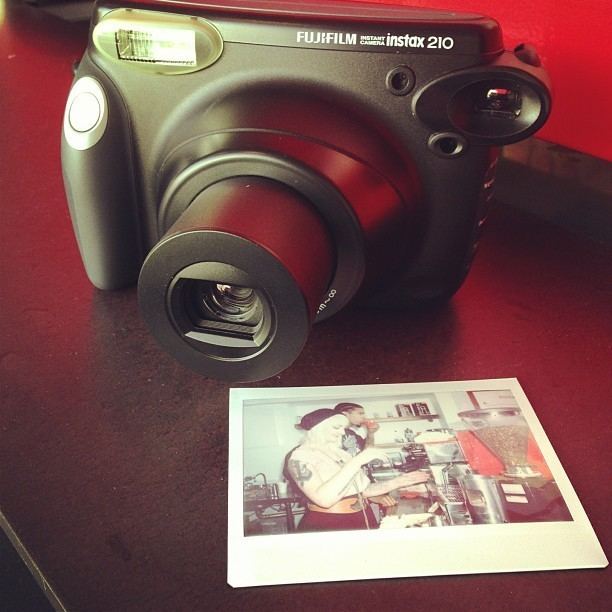Format Mini, Wide | Speed 800/30° Balance Daylight Introduced 1998 | |
 | ||
Instax (stylized as instax) is a brand of instant still cameras and instant films marketed by Fujifilm. The first camera and accompanying film, the Instax Mini 10 and Instax Mini film, were released in 1998. The "Wide" film and first camera were released the following year. The two formats of Instax film give an image size of 46 mm × 62 mm (1.8 in × 2.4 in) and 99 mm × 62 mm (3.9 in × 2.4 in), for the Mini and Wide respectively. Other manufacturers also make compatible cameras and camera backs.
Contents
Cameras and printers
Fujifilm produces a range of Instax Mini and Instax Wide cameras, as do other manufacturers. Fujifilm also produces Instax Mini printers and has in the past produced Instax Pivi printers.
Film characteristics
Fuji's instant film products are based upon the improvements made to Polaroid's SX-70 instant film system that the Eastman Kodak Company sold in the 1970s and 1980s – namely the ability to expose the film through the rear of the photograph and the reversal of the dye layers' order so that development in the blue layer is visible first. As a result of these changes, the image does not need to be taken via a reflex mirror in order to reverse the image (as all Polaroid integral film cameras do). Colour balance and tonal range are also improved over Polaroid integral instant films. Fuji's decision to integrate the pressure plate springs and batteries into the camera bodies rather than the disposable film pack itself helps make the Instax system more economical per exposure than Polaroid's equivalents.
Instax Mini
Instax Mini is an 54 mm × 86 mm (2.1 in × 3.4 in) (approximately ISO/IEC 7810 ID-1 credit-card-size) integral daylight ISO 800 color film designed for use with Fujifilm instax mini compatible cameras. The Mini film and camera systems are also called Cheki (チェキ) in Japan; the Cheki moniker derives from the English "check it".
Digital Instax Pivi
The Digital Instax Pivi line was intended as a digital/analog hybrid. The original intention was to produce a new format to feed a series of digital instant cameras similar in approach to the Olympus C-211, a digital camera with a built-in Polaroid 500 film printer. Fujifilm eventually released the FinePix PR21, a digital camera with a built-in Instax mini printer, in 1999. A stand-alone printer was planned from the start but was not the primary focus, but this changed with the advent of mobile devices. This device made it to market in 2004, after about five years in development.
Instax Pivi film looks physically identical to Instax mini, but it takes a different formulated film producing an inverted image when used in a mini camera, making them deliberately incompatible to a fault.
Instax Wide
Released the year after the mini film and cameras, the negative was increased on this format to create an image size based on the golden ratio. Upon introduction, this format was simply called Instax without any suffix (making it the normal, not mini, Instax film), Fujifilm gradually embedded the "Wide" moniker into the name of the product. That rebranding pattern can also be seen on the Instax 210 which is now described on the Fujifilm web site as Instax Wide 210, despite not being referenced elsewhere in such a way.
Instax Square
Instax Square is a new 1:1 size of Instax film, to be released with an accompanying camera in spring of 2017.
Pre-Instax
Kodak ceased production of instant film cameras when it was successfully sued by Polaroid for patent infringement in 1986. Fujifilm, through an agreement with Polaroid specifying they could not officially distribute in certain territories (such as the US) until the original patents expired in the mid-1990s, continued to manufacture and market their own line of films. As such, Fuji produced several lines of instant films starting in the early 1980's.
Release
Instax was released to consumers in 1998 and was based on those earlier instant film systems, having the same film speed and dye order.
Fujifilm originally wished to release the Instax series worldwide including North America and Europe simultaneously, but chose to work with Polaroid on the mio camera based on the Instax mini 10/20 for the US market. The mio product was discontinued after a few years.
Polaroid withdraws
With Polaroid ceasing production of instant films in 2008, the Instax system was the only integral instant film system in production until The Impossible Project launched their integral film in early 2010. The Instax Mini system is also sold in some markets by Polaroid itself through the Polaroid 300 and Polaroid 300 Film brands (in reality, rebranded Instax Mini 7S and Instax Mini film).
Reception and growing popularity
In 2014 it was reported that the Instax Mini 8 was outselling flagship models like the Fujifilm X-T1 and Sony α7R.
In 2016 it was reported that sales of Instax cameras had risen to 5 million units the previous fiscal year, up from 100,000 units in 2004. Also that year, Fujifilm released a monochrome formulation of the film.
